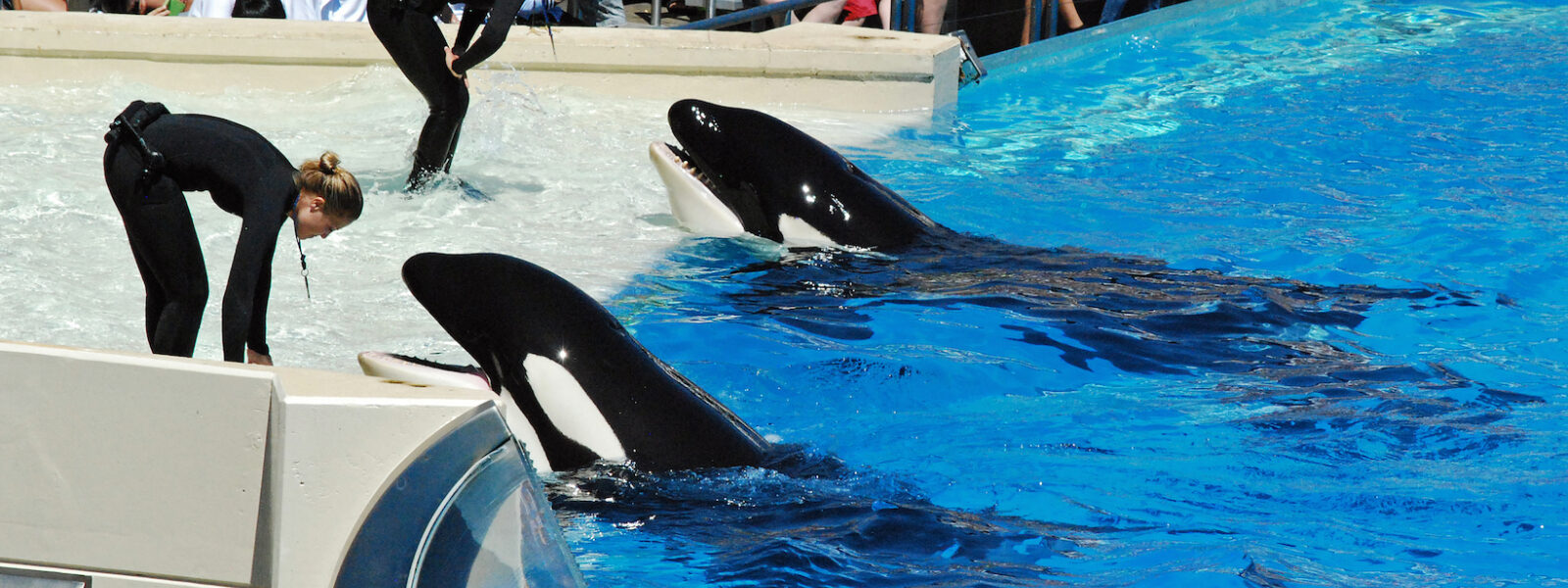

Over the last six years, SeaWorld’s reputation has been irrevocably blackened as the world learns about the deplorable failures to keep orcas, dolphins and belugas alive and well in their facilities and the cruelty that cetaceans experience in captivity. As SeaWorld keeps failing, dolphins and whales come closer to being retired or set free.
This list has been adapted from one originally published in NY Times.
February 2010 — During a “Dine with Shamu” show, Tilikum the orca whale was performing with SeaWorld trainer Dawn Brancheau at SeaWorld Orlando when he suddenly pulled her beneath the surface and killed her. Tilikum is assumed to have severe psychosis due to his lifetime of trauma at various facilities, since his capture from the wild oceans of the Pacific Northwest. The death of Brancheau was the third human death associated with Tilikum.
January 2013 — Blackfish first hit theaters at Sundance Film Festival and ignited another wave of awareness of the plight of captive cetaceans. The film built off of the momentum of The Cove, the Oscar-winning documentary that highlights Earth Island’s work to show the links between dolphin slaughters and the captivity industry. Blackfish is shown often on CNN during the next two years.
November 2013 — When word got out that SeaWorld would be driving a float that featured Shamu in the Macy's Thanksgiving Day Parade, protesters attempted to block it. When this failed, throngs of angry people lined the streets and made their opinions known to the company and onlookers.
December 2013 — SeaWorld invited bands to play at annual festivals they host at their facility. This year, Heart, Barenaked Ladies and Willie Nelson canceled their performances at SeaWorld in Florida, citing public opposition to SeaWorld due to Blackfish. Singer Joan Jett objected to SeaWorld using one of her songs to promote the park.
July 2014 — Under pressure from activists on social media, Southwest Airlines ended a 25-year marketing partnership with SeaWorld.
August 2014 — In an attempt to repair their ailing public image, SeaWorld unveiled plans for the Blue World project, ostensibly to increase the space and welfare for orcas at the SeaWorld San Diego facility. Further details later emerged indicating that SeaWorld planned to intensify breeding operations, revealing their true motivations for building bigger tanks to hold more captive orcas.
December 2014 — SeaWorld layed off more than 300 people, and CEO Jim Atchison resigned from his post.
March 2015 — SeaWorld dumped $10 million dollars into a PR campaign in a bid to make people forget about Blackfish. This included a #AskSeaWorld Twitter campaign, which backfired spectacularly as people used the hashtag to ask the company about their poor treatment of cetaceans.
April 2015 — Earth Island’s International Marine Mammal Project (IMMP) helped launch litigation on behalf of two SeaWorld customers who alleged that false and misleading claims were made by SeaWorld about the health and welfare of cetaceans.
May 2015 — SeaWorld was cited in California for not adequately protecting its killer-whale trainers at its park in San Diego. The California Division of Occupational Safety and Health issued four citations against SeaWorld for not adequately protecting trainers from captive orcas. The fines totaled nearly $26,000.
July 2015 — Animal protection organizations claimed that SeaWorld employees have been posing as activists in order to incite violence among protesters. SeaWorld suspends the person and opens an investigation.
August 2015 — In the first hearing for the lawsuit supported by Earth Island’s IMMP, the court heard that SeaWorld claims that orcas are “happy” in captivity, that they do not separate mothers and babies, and that SeaWorld manipulates scientific findings to boost their public image. The court rejected SeaWorld’s effort to move all lawsuits to friendly courts in Florida. SeaWorld reported profits plunging by a shocking 84%, citing “continued brand challenges”.
September 2015 – SeaWorld claimed it will no longer purchase any of the 18 wild-caught belugas that a consortium of aquariums, including SeaWorld and the Georgia Aquarium, attempted to import into the United States from Russia. It was presumed this about-face was due to public pressure campaigns, including a pledge launched by Richard Branson. Georgia Aquarium later loses its lawsuit to import the beluga whales, another victory for Earth Island’s IMMP and our colleagues who intervened.
October 2015 — The California Coastal Commission approved the $100 million dollar Blue World tank expansion project, but placed conditions on the permit that would ban breeding and transferring of orcas to or from SeaWorld San Diego. SeaWorld challenged this ruling, calling the Commission’s jurisdiction into question.
November 2015 — SeaWorld announced it will end orca shows at its San Diego park by 2017, to be replaced by more “natural” viewing of orcas.
December 2015 — As expected, SeaWorld sued the California Coastal Commission over the ban on forced breeding of captive orcas, while the world enjoys a holiday break.
February 2016 — SeaWorld’s CEO Joel Manby released a statement acknowledging that it sent its own employees to infiltrate and spy on the animal rights group PETA. Earth Island’s IMMP moved to intervene, on behalf of captive orcas, in the case filed by SeaWorld against the California Coastal Commission.
To be continued...